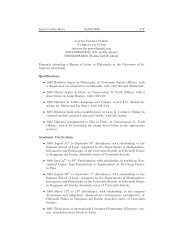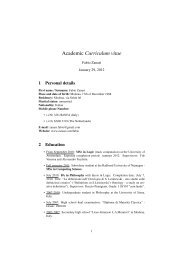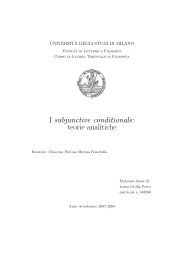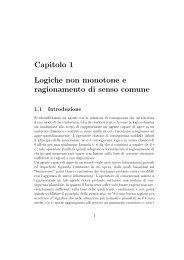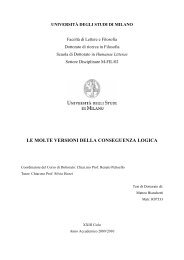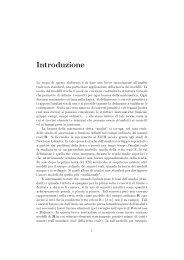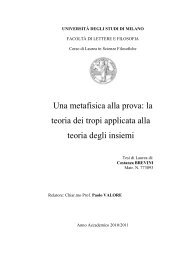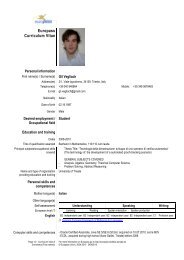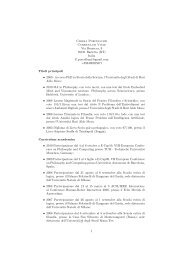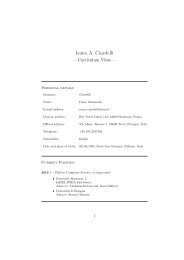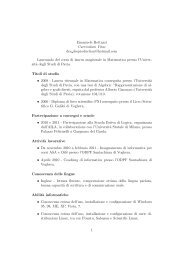Ω-Theory: Mathematics with Infinite and Infinitesimal Numbers - SELP
Ω-Theory: Mathematics with Infinite and Infinitesimal Numbers - SELP
Ω-Theory: Mathematics with Infinite and Infinitesimal Numbers - SELP
Create successful ePaper yourself
Turn your PDF publications into a flip-book with our unique Google optimized e-Paper software.
CHAPTER 1. Ω-CALCULUS<br />
Proposition 1.7.6. Let E ⊆ R. E = E ∗ if <strong>and</strong> only if E is finite.<br />
Proof. If E is finite, we can apply Proposition 1.4.2 <strong>and</strong> obtain immediately E ∗ = E.<br />
If E is infinite, then it’s not bounded or it’s bounded <strong>and</strong> have an accumulation<br />
point p ∈ R. In the first case, we can find a function ϕ : Pfin(Ω) → E such as<br />
for all n ∈ N one of the relations ϕ(λ) > n or −ϕ(λ) > n eventually holds, <strong>and</strong> so<br />
limλ↑Ω ϕ(λ) is an infinite number that doesn’t belong to E.<br />
In the second case, we can find a function ϕ : Pfin(Ω) → E such as |ϕ(λ) − p| <<br />
1/|λ| <strong>and</strong> ϕ(λ) = p. Taking the Ω-limit of both sides <strong>and</strong> calling ξ = limλ↑Ω ϕ(λ),<br />
we have that |ξ − p| < 1/k for all k ∈ N, so that |ξ − p| is infinitesimal or, in other<br />
words, ξ ∈ mon(p). Now, ϕ(λ) = p for all λ ∈ Pfin(Ω), so ξ = p, <strong>and</strong> this implies<br />
ξ ∈ R. Since ξ ∈ E ∗ <strong>and</strong> ξ ∈ E, we conclude E ∗ = E, as we wanted.<br />
Proposition 1.7.7. Let E ⊆ R. E ◦ = E ∗ if <strong>and</strong> only if E is finite.<br />
Proof. If E is finite, then, by Proposition 1.7.6, we have E = E ∗ ⊇ E ◦ ⊇ E, <strong>and</strong><br />
the thesis follows.<br />
If E is infinite, we want to show that E ∗ \ E ◦ = ∅ or, in other words, we want to<br />
show that there is a function ψ : Pfin(Ω) → E such as for every ϕ : Pfin(Ω) → E we<br />
have ζ = limλ↑Ω ψ(λ) ∈ E ◦ . To do so, first notice that, for all λ ∈ Pfin(Ω), E \λ = ∅,<br />
because E infinite <strong>and</strong> λ is finite. This implies that there exists a function ϕ such as<br />
ϕ(λ) ∈ E \ (λ ∩ E) for all λ ∈ Pfin(Ω). Now, since every ξ ∈ E ◦ is the Ω-limit of a<br />
function ϕ such as ϕ(λ ∩ E) ∈ λ ∩ E, it’s clear that, by definition, for all such ϕ we<br />
have ψ(λ) = ϕ(λ ∩ E). This <strong>and</strong> Proposition 1.4.1 ensures that ζ = limλ↑Ω ψ(λ) = ξ<br />
for all ξ ∈ E ◦ . By definition, we have also ζ ∈ E ∗ , so that ζ ∈ E ∗ \ E ◦ , as we<br />
wanted.<br />
It turns out that the relation between E ◦ <strong>and</strong> E ∗ can be further characterized:<br />
Proposition 1.7.8. for all E ⊆ R, E ◦ = E ∗ ∩ R ◦ .<br />
Proof. First, let’s suppose that ξ ∈ E ∗ ∩R ◦ . We can find a function ϕ : Pfin(Ω) → E<br />
such that limλ↑Ω ϕ(λ) = ξ <strong>and</strong> a function ψ : Pfin(Ω) → R such that ψ(λ) ∈ λ <strong>and</strong><br />
limλ↑Ω ψ(λ) = ξ. Since ϕ <strong>and</strong> ψ have the same Ω-limit, we have that Qϕ,ψ ∈ Q <strong>and</strong><br />
so ψ(λ) ∈ E for all λ ∈ Qϕ,ψ, but this implies ψ(λ) ∈ E ∩ λ for those λ. Thanks to<br />
Proposition 1.7.2, we can safely conclude that ξ ∈ E ◦ . This proves E ◦ ⊇ E ∗ ∩ R ◦ .<br />
The other inclusion is straightforward: if ξ ∈ E ◦ , then by definition we have<br />
ξ ∈ E ∗ <strong>and</strong> ξ ∈ R ◦ , so that ξ ∈ E ∗ ∩ R ◦ .<br />
Thanks to this Proposition, a lot of results about natural extension of sets will<br />
apply also to hyperfinite extension. Now, we will show that the operation of natural<br />
extension commutes <strong>with</strong> set operations <strong>and</strong>, as a consequence, we will obtain that<br />
the same result holds for hyperfinite extension.<br />
Proposition 1.7.9. for all E, F ⊆ R, the following are true:<br />
20<br />
1. E ∗ ∩ F ∗ = (E ∩ F ) ∗ ;<br />
2. E ⊆ F implies E ∗ ⊆ F ∗ ;




